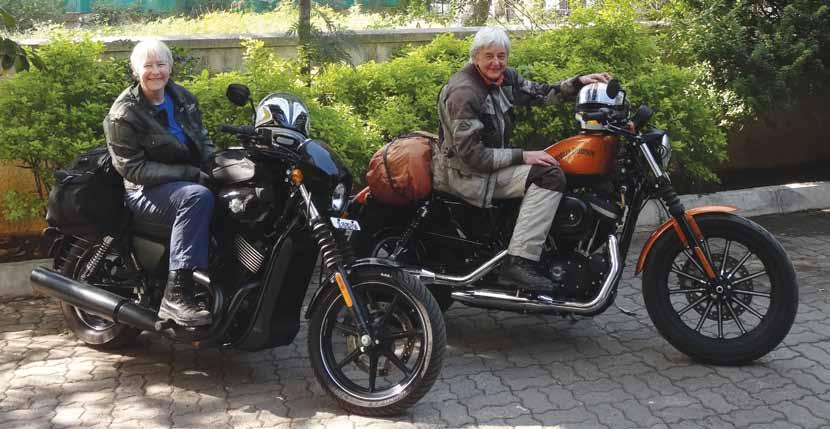
10 minute read
India by Harley
South india by Harley
Aren’t Royal Enfields compulsory in India? Not when you’ve got a Harley Sportster and Street 750
Advertisement
Words & Photography: Pat Thomson and Sheonagh Ravensdale
Never in our wildest dreams did we imagine we would be touring India on a couple of Harleys, a then-new Street 750 and an 883 Sportster. Nor, after Sheonagh’s last trip (Rajdoot 350 in 1987) did she envisage cruising easily and comfortably on excellent highways at 75mph and more. In Europe Sheonagh normally rides a Suzuki Bandit 600 and Pat a CBR600, so our rides are very different, but when HD India and BIKE INDIA magazine offered us two new bikes, we jumped at the chance.
Indian traffic is somewhat challenging to say the least and we started out nervously in the late December morning rush through Pune onto Highway 4.
We took the tunnel that carved through the first ghat, surprised by totally unlit vehicles in the tunnel and those that put their hazards on and honk their way through. The highway beyond was busy most of the way to Kolhapur and we soon learned to undertake the lorries hogging the outside lane, but had to watch out for bullying cars that squeezed into any available gap. Still, the surface was excellent and the V-twins lapped up the kilometres easily and very comfortably. The Street has negligible vibration and handles remarkably like the Japanese bikes we are used to, plus the ability to accelerate quickly to get out of trouble.
After Kolhapur, traffic eased off and we could start to appreciate the changing countryside scenes. Women walked down the side of the road with bundles of firewood on their heads; cartload after cartload piled high with sugar cane slowly made their way, and we were surprised to see a couple of them coming towards us in the outside lane of our carriageway.... Speedbumps infest the villages and small towns along the way and however slowly we rode over them, the Harleys ground all too often.
After an overnight stop in Belgaum (nice safe underground garage for the bikes at Sai Sangam Int’l Hotel), we pressed on to Hampi. Palm trees lined the approach road to town and after
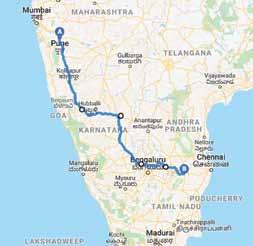
Above: shiny Harleys, ready to set out from Pune

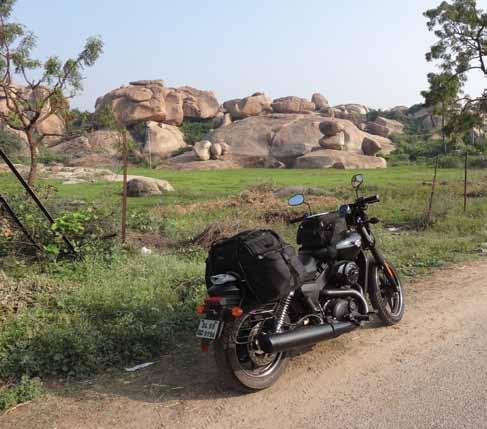
Pat strikes a pose, sunset at Hampi
Above left:
Lotus Mahal, Hampi Above: Hampi boulders are some of the oldest exposed rocks on earth Right: Chillis drying by the road to Hampi
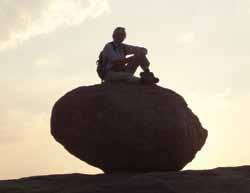
some initial confusion we found our cozy hostel Ranjani in a quiet corner of the bazaar, and got a great welcome from the family which owns it. Bike parking was outside, but we put the Harry Potter invisibility cloaks on them and they disappeared from prying eyes – just simple bike covers!
We spent New Year’s Day visiting the main temple sights with our rickshaw driver Jilan who was also a knowledgeable guide. Hundreds of children shouted Happy New Year, demanded to shake our hands and wanted their photos taken with us. We loved the festive saris worn by many of the women; the splashes of colour contrasted beautifully against the sandy-coloured buildings.
A massive amount of archaeological restoration has been done since Sheonagh was here in 1987 and Hampi is deservedly a World Heritage Site. First mentioned in the Ramayana as Kishkinda, home of the monkey gods, in the 14th century Hampi became the Telegu capital Vijayanagar. Within 200 years it had a population of half a million and was one of the largest Hindu empires in Indian history. Its location in a boulder-strewn landscape is unique.
With its large temples and intricate carvings in impressive courtyards, bath houses for queens, secret underground meeting places, tiered water tanks, small temples perched on rocks or tucked into crevices and of course the famous Elephant Stables and Stone Chariot, you could spend days wandering round the 45 square km of the city.

Bikerni Women
We needed a chillout day after this and climbed onto a small, crammed ferryboat which wobbled precariously, engine stuttering, across the river before we settled down in the Ooh La La Cafe for lunch.

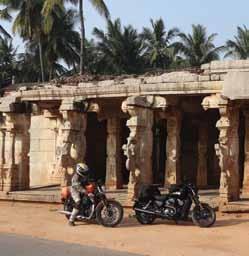
Left: ever seen a temple with wheels? This represents Vishnu’s chariot Above: Chandikeshvar Temple, Hampi Below: left: Bengaluru Bikerni bike club got up at 5.30am for a ride out Below: Cool roadside chai stops were welcome

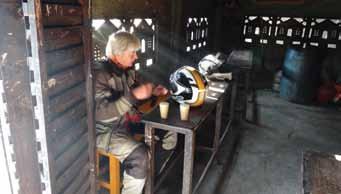
Suddenly we heard a Tiger roar... it was Junaid from local bike shop Art of Motorcycles on his new Triumph, come to visit his Nepalese biker friend who owns the cafe. We were staggered to hear the OTR cost of the Tiger – 17.5 lakhs (about £19,000), or double what you would pay in England. We spent a wonderful afternoon with him, swapping biking tales of adventures in different parts of the world. Amongst other things, Junaid has a fleet of 53 Enfields and organises group trips to the Himalayas. Finally we tore ourselves away and hopped into a woven coracle, back across the river.
We were keen to meet up with the Bangalore Bikerni girls, an all-women bike club and on Junaid’s suggestion we rode to Tumkur to meet them there. The 30-mile stretch of main road south from Hospet, until we reached the highway, was slow, bumpy and very busy with extra wide loads (wind turbine parts) crawling towards us. We could see wind farms on all the hills, and more are obviously planned. When we hit the highway it was a good road and a fast ride down to Tumkur, where Junaid’s cousin Majid met us and led us to the hotel they had booked (and paid) for us.
Early next morning we heard the sound of bikes and hurried downstairs to meet the Bikerni girls who had met up at 5.30am to ride up to meet us. We compared riding gear. The girls said it is impossible to find proper riding trousers in India – a business opportunity here for somebody? We had a great time chatting, and most of them were barely born when Sheonagh last rode round India! They are all passionate about bikes and were on Bullets, an Avenger (220cc custom bike) and a Yamaha R15 (like an R1, but 155cc). Reena had her 16-year old daughter on the back, while Viksha cannot wait to be allowed to ride a proper bike!
After breakfast (Pat’s first idlis and wadas) the Bikerni rode with us, bypassing Bengaluru, and set us on the right road towards Chennai. It was great to meet such a feisty, enthusiastic group of female riders.
Later that day there were long stretches with a good surface and not much traffic but we saw three accidents, one of them a rickshaw which had rolled right over. Few people take notice of such signs as ‘Traffic Violators are Accident Makers,’ and, ‘Safe Driving is like Breathing... Don’t Stop It!’
Into Vellore and the maelstrom of a major Muslim festival, Miladi Nabi. Throngs of women and excited children crowded the pavements and the park around the town’s ancient fort. Loud music from every direction filled the air and snarled-up traffic hooted madly. We sought refuge from the noise and the crowds with a walk along the ramparts of the massive 16th century Vijayanagar Fort, surrounded by a moat.

Above: Navigation by iPad and committee Below: some crops are left to dry on the road – And we complain about tractors...

Heading back through the crowds, we witnessed a tiny tragedy. Up on a hoarding above us monkeys ran back and forth gibbering and pointing. We looked at the road and there was a smashed up monkey lying in a pool of blood. One monkey looked straight at us and uttered a reproachful cry. I felt bad we didn’t have gloves to bring their dead companion out of the road, but we would have been run over ourselves if we had tried.
Hotel Darling Residency in Vellore has safe, guarded parking at the back, but we disc-locked the bikes and put the covers on anyway. It also has an excellent restaurant on the roof which was so breezy no fans were needed.
Perhaps we should also introduce ourselves at this point? Both of us have been riding for over 40 years and clocked up riding in over 45 countries on a variety of bikes. Even in hot countries we always wear protective clothing, in this case Shoei helmets, a mix of Hein Gericke and Gialli jackets/trousers and Altberg boots. Pat is a retired underwater acoustics research scientist, so she concentrates on the technical details, checks the bikes over and does the navigation. Sheonagh was a professional conference organiser, so she sorts the admin on the road, finds the hotels and chats to everybody!
Sheonagh Ravensdale is Acting Communications Director for the BMF. She and Pat rode on through India to Kanyakumari at the southern tip then up through the Nilgiris to Goa to speak at India Bike Week. To read part 2 of this article, email Sheonagh at: sheonagh.ravensdale@bmf.co.uk
The Bikes: Harley 883 Iron & Street 750
So what about the bikes? Of the two, the 883 Iron attracted most attention on Indian streets. People loved the blingy appearance, the bronze metallic colour and shiny chrome pipes. The more discreet and conventional black Street 750, with a less distinctively Harley exhaust note didn’t garner as much attention, but when people were told it was built in India, they got very excited! The next question (after ‘photo please’) was how much they cost, rapidly followed by the fuel consumption. Both bikes gave similar figures, with the 883 fractionally more economical (though this may be down to riding style) at 70mpg – the 750 gave 67mpg. On highways and clear roads, we were getting around 80mpg, down to as low as 55mpg in heavy slow traffic. The 883 has a relatively small tank at 12 litres, but this should stilll give you a range of 120 miles.
Riding such large heavy machines as the Harleys after buzzing around on lightweight 150s makes you very conscious of how much you use counter steering to swing them around. The 883 had quite noticeable vibration at 3000rpm (about 60mph in 5th gear) making the hands go fuzzy and mirrors blurry. Riding through some very rough diversions with loose surfaces at roadworks, both bikes rode well and felt very stable. The gound clearance on both bikes necessitate great care when tackling speed bumps, and ladies, if you want to ride a Harley on Indian roads, we suggest you also invest in a good quality sports bra!
We weren’t impressed by the maintenance regime, as it wasn’t easy to find basic information such as tyre pressures, what oil to use and how to do coolant level checks on the 750 – there was no owners’ manual on the bikes, or even a basic toolkit. We attempted to find the information from the HD website but all we could get were twiddling icons.
Finally, luggage. We prefer soft luggage, and after a trip through South America acquired the nickname ‘dusty old bags’, because that’s what our luggage was carried in! We also like to travel with more than just a change of underwear and a credit card. For this trip, we had been intending to just strap a small soft bag onto the back of each bike, and this was the solution for the 883, though it wasn’t possible to fit a tank bag. It fitted well, even though there was no pillion seat. For the 750, we were loaned an excellent set of Vaterra panniers that fitted well over the pillion seat plus a good size tank bag.
This article was originally published 2016 in BIKe INDIA magazine, which arranged the loan of the two Harleys.










